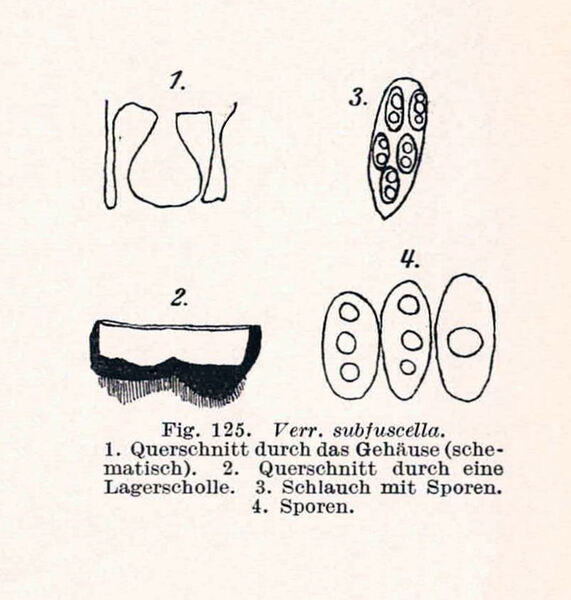Verrucaria polysticta Borrer
in Hooker & Sowerby, Suppl. Engl. Bot., 2: tab. 2741, 1834.
Synonyms: Dermatocarpon subfuscellum (Nyl.) Servít; Verrucaria fuscella var. nigricans Nyl.; Verrucaria nigricans (Nyl.) Zschacke; Verrucaria subfuscella Nyl.
Distribution: S - Si (Brackel 2008b, Brackel & Puntillo 2023).
Description:
Verrucaria polysticta Borrer - Thallus crustose, episubstratic, well developed, grey to pale brown with darker lines delimiting smaller thallus units, areolate, 0.28-1 mm thick in central parts but the margin thin and the primary areoles arising on the prothallus, these round or oblong, up to 0.28 x 0.4 mm, soon becoming crowded and forming a thicker crust which becomes cracked; mature areoles 0.3-1.1 mm wide, angular, flat to slightly concave; prothallus blackish, rarely grey to brown. Cortex poorly defined, with a brownish pigment, sometimes overlain by an epinecral layer; medulla thick, dark reddish brown, but without a black basal layer. Perithecia black, immersed in the areoles (rarely marginal), up to 14 per areole, arising between the thallus units visible in surface view and appearing as connected by dark lines, the apex appearing as a dark, 0.1-0.25 mm wide disc. Involucrellum absent; exciple 0.18-0.29 mm across, the wall brown or dull greenish brown in upper part, paler in lower part, but usually flanked by dark tissue; hamathecium of periphyses and periphysoids, interascal filaments absent; hymenial gel hemiamyloid, I+ red (I+ blue at very low concentrations of I), K/I+ blue. Asci 8-spored, clavate, I-, fissitunicate, the wall thickened above, with an ocular chamber, dehiscent by extrusion of an endotunica to form a delicate rostrum, Verrucaria-type. Ascospores 1-celled, hyaline, oblong-ellipsoid or ellipsoid, (10.5-)12.5-15.5(-16.5) x 5.5-7(-8) μm. Photobiont chlorococcoid. Spot tests: K-, C-, KC-, P-, UV-. Chemistry: without lichen substances.
Note: on calcareous rocks, often growing on the thalli of other crustose lichens, especially Circinaria calcarea and Verrucaria nigrescens; probably more widespread in Italy, but often confused with Placopyrenium canellum in the past.
Growth form: Crustose
Substrata: rocks
Photobiont: green algae other than Trentepohlia
Reproductive strategy: mainly sexual
paras crustose lichens
Commonnes-rarity: (info)
Alpine belt: absent
Subalpine belt: rare
Oromediterranean belt: rare
Montane belt: rare
Submediterranean belt: rare
Padanian area: extremely rare
Humid submediterranean belt: rare
Humid mediterranean belt: rare
Dry mediterranean belt: rare

Predictive model
Herbarium samples


Felix Schumm – CC BY-SA 4.0
[12298], Griechenland, N-Samos, bei Manolates südlich von Agios Konstandinos, 37°47.185'N, 26°49.533'E, 341 m; halbschattige bis besonnte Terrassenmauern. Leg. Schumm 02.05.2006, det. Schumm 2006.
as v. subfuscella


Felix Schumm – CC BY-SA 4.0
[12298], Griechenland, N-Samos, bei Manolates südlich von Agios Konstandinos, 37°47.185'N, 26°49.533'E, 341 m; halbschattige bis besonnte Terrassenmauern. Leg. Schumm 02.05.2006, det. Schumm 2006.
as v. subfuscella


Felix Schumm – CC BY-SA 4.0
[12298], Griechenland, N-Samos, bei Manolates südlich von Agios Konstandinos, 37°47.185'N, 26°49.533'E, 341 m; halbschattige bis besonnte Terrassenmauern. Leg. Schumm 02.05.2006, det. Schumm 2006.
as v. subfuscella


Felix Schumm – CC BY-SA 4.0
[12298], Griechenland, N-Samos, bei Manolates südlich von Agios Konstandinos, 37°47.185'N, 26°49.533'E, 341 m; halbschattige bis besonnte Terrassenmauern. Leg. Schumm 02.05.2006, det. Schumm 2006.
as v. subfuscella
Growth form: Crustose
Substrata: rocks
Photobiont: green algae other than Trentepohlia
Reproductive strategy: mainly sexual
paras crustose lichens
Commonnes-rarity: (info)
Alpine belt: absent
Subalpine belt: rare
Oromediterranean belt: rare
Montane belt: rare
Submediterranean belt: rare
Padanian area: extremely rare
Humid submediterranean belt: rare
Humid mediterranean belt: rare
Dry mediterranean belt: rare

Predictive model
| Herbarium samples |


Felix Schumm – CC BY-SA 4.0
[12298], Griechenland, N-Samos, bei Manolates südlich von Agios Konstandinos, 37°47.185'N, 26°49.533'E, 341 m; halbschattige bis besonnte Terrassenmauern. Leg. Schumm 02.05.2006, det. Schumm 2006.
as v. subfuscella


Felix Schumm – CC BY-SA 4.0
[12298], Griechenland, N-Samos, bei Manolates südlich von Agios Konstandinos, 37°47.185'N, 26°49.533'E, 341 m; halbschattige bis besonnte Terrassenmauern. Leg. Schumm 02.05.2006, det. Schumm 2006.
as v. subfuscella


Felix Schumm – CC BY-SA 4.0
[12298], Griechenland, N-Samos, bei Manolates südlich von Agios Konstandinos, 37°47.185'N, 26°49.533'E, 341 m; halbschattige bis besonnte Terrassenmauern. Leg. Schumm 02.05.2006, det. Schumm 2006.
as v. subfuscella


 Index Fungorum
Index Fungorum
 GBIF
GBIF




